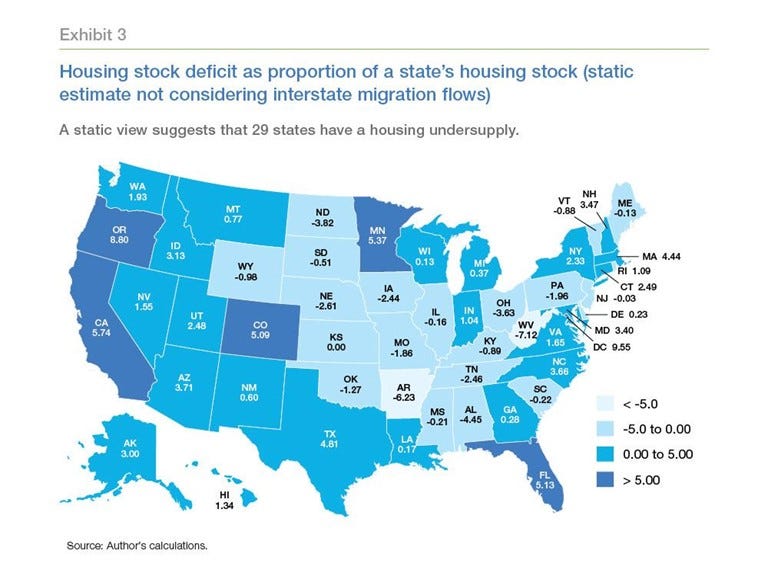Housing Innovation: A Response to Oregon’s Crisis
Several partners are developing a Housing Innovation Plan to help produce more housing units ASAP. None of this can be done without the leaders from the public, private and civic sectors.
As of 2019, Oregon is in a tie for having the worst housing deficit in the United States.
ECONorthwest estimates that the state should be building 29,000 units a year to meet demand, and each year we have been falling well short of that goal. In fact, recent studies suggest we have a current deficit of 140,000 dwellings statewide. Current housing production is not keeping up with demand, much less making progress on the deficit. The homeless crisis in Oregon is also one of the country’s worst. Freddie Mac tracks states’ overall housing deficits as follows:
Oregon has invested hundreds of millions of dollars in affordable housing which addresses part of the problem but by itself is an incomplete solution. These investments are necessary but not sufficient. The average cost to build an affordable housing unit is over $300,000 and they take about four years to build, given complex financing needs and multiple investors.
Over 50% of Oregon’s needed housing falls outside of the definition of affordable housing, such as workforce housing for people like teachers, firefighters, and other service providers. This housing type is in very short supply all over the state and particularly impacts communities with struggling economies as they cannot provide adequate housing to attract or retain a qualified workforce.
Obviously, approaching Oregon’s housing crisis as we have will not solve our problem. Innovation is needed to deal with all levels and aspects of our housing crisis. We need to develop new ways to create less expensive and new kinds of construction, improve Oregon’s modular and manufactured housing production capacity, deal with regulatory barriers, provide home ownership strategies, create new financing models, and provide transitional and permanent housing for the homeless.
We also need to invest in cities and counties who can update comprehensive plans and zoning ordinances to accommodate housing but have lacked the resources to do so. We need innovation in all these areas – and more – to confront the crisis.
The key to housing innovation is getting all the sectors involved working together. To that end, a Housing Innovation Partnership has been initiated and assisted by the Oregon iSector, which helps broker and support cross-sector partnerships to address pressing public issues. State Representative Pam Marsh (D-Ashland) and Megan Loeb from the Oregon Community Foundation (OCF) are providing the co-convening leadership for the new Partnership which is developing a number of housing innovation strategies.
The partners come from all sectors - government, business, the nonprofit world, and foundations. Among others, the diverse partners who are bringing potential innovations to the table include:
the Port of Portland - which is working to developing a modular/mass timber manufacturing facility;
the City Manager of John Day, Oregon - bringing 3D printing of homes to that rural community;
Hacienda CDC - building prototype housing kits using mass timber;
the Oregon Home Builders Association - developing a new vertical workforce housing concept;
advocates for expanding Project Turnkey using motels for shelter, transitional and permanent housing for the homeless; and
the Association of Oregon Counties and League of Oregon Cities who represent local jurisdictions that develop and maintain Comprehensive Land Use Plans that guide development.
The Housing Innovation Partnership has also identified research and capacity building as key supports for innovation in housing. ECONorthwest, university programs like the Tallwood Institute, a cooperative effort between the University of Oregon and Oregon State University, and the Meyer Foundation conduct research that can underpin innovative housing strategies. Through the Partnership, the Department of Land Conservation and Development will work with Oregon cities and counties, along with the Oregon REALTORS® to determine how to provide adequate levels of staffing to accommodate the needed housing in their land use plans. These actionable plans will make Oregon a better place to both live and work.
These innovators believe we can create new construction methods using mass timber that employ Oregon forest resources sustainably while improving forest health. They believe we can create housing kits that can be produced at an affordable price and assembled quickly. They believe we can create home ownership while using infill lots efficiently by building vertically. They believe we can develop new financing approaches that will make it easier to build housing for teachers, firefighters, and service workers. They believe that we can harness new technology to build housing in rural Oregon. And, they believe that we can find ways to retrofit motels and other existing buildings to help the homeless transition into permanent housing.
They believe that, because all innovation will need to work in communities, the state can partner with our cities and counties as they reimagine how our communities can accommodate our needed housing.
These partners are working to develop a Housing Innovation Plan to help produce more housing units as soon as possible. They have come together to imagine what we can do to transform our state into a place where every Oregonian has a safe and secure home.
None of this can be done without the leaders from the public, private and civic sector working together. Rep. Marsh and Megan Loeb from OCF are providing the cross-sector leadership at the state level to do just that. The next step will be to create local partnerships that can implement the innovations that come from this statewide effort in communities around the state and give us a new way to respond to our housing crisis.
Greg Wolf is the co-founder of the National Policy Consensus Center, and founded Oregon Solutions, Oregon Consensus, Regional Solutions and County Solutions. He is now the Director of the Oregon iSector.
Photo credit: "Matt Court construction cranes" by andrechinn is marked with CC BY 2.0.







I strongly agree with your emphasis on addressing supply; other interventions, such as vouchers and housing navigators, don't work well when we're short 140,000 housing units in Oregon. But one question on your numbers. In your first sentence, you say that Oregon ties for having the worst housing deficit in the US; what's the source on that, and what metric are you using? In the graphic just below that, attributed to Freddie Mac and author calculations, you show Oregon having a housing stock deficit equivalent to 8 percent of current supply, and on the map that appears to be the highest in the country by a good margin based on your figures. Is that your source and if so, what state is tied with Oregon for having the highest percentage deficit?